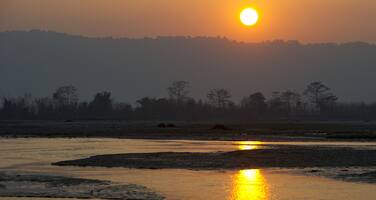Chitwan National Park
Factors affecting the property in 1990*
- Water (extraction)
International Assistance: requests for the property until 1990
Total amount approved : 80,000 USD
| 1989 | Public awareness programmes and development of an ... (Approved) | 50,000 USD |
| 1988 | Consultancy services for the preparation of a plan for ... (Approved) | 30,000 USD |
Missions to the property until 1990**
Conservation issues presented to the World Heritage Committee in 1990
The Secretariat transmitted the Bureau's concerns regarding the impact of a proposed irrigation project to divert the Rapti river, which forms the northern boundary of this Park, to relevant authorities in Nepal and in the Asian Development Bank by letters dated 9 August 1990. The Asian Development Bank, by letter of 30 August 1990, has indicated that the Bank was "...equally concerned with the possible adverse effects..." of the East Rapti Irrigation Project on the wildlife of the Royal Chitwan National Park. The Bank had requested consultants to carry out a detailed environmental impact assessment study which is expected to be completed in the last quarter of 1990.
The Government of Nepal and the Bank have commissioned other studies, including a survey of existing farmer-managed irrigation schemes in the area, which would also be completed by the end of this year. The future status of the project will be jointly reviewed by the Government of Nepal and the Bank, on the basis of the conclusions of these studies and the likely options resulting from this review, and a set of alternatives will be foreseen. The Asian Development Bank indicated that it would keep the Secretariat informed of the future status of the project, as has been agreed with the Nepalese authorities, as a result of this review.
Summary of the interventions
Decisions adopted by the Committee in 1990
14 BUR IV.A.26
Royal Chitwan National Park (Nepal)
The Bureau was informed that a US $30 million irrigation project, to be implemented with the assistance of a Japanese company and the Asian Development Bank, could divert about 75 per cent of the waters of the Rapti River which forms the northern boundary of the park and that no study on the environmental impact of this irrigation project had so far been undertaken. The Bureau recalled that a sum of US $80,000 had been provided during 1988-1989 from the World Heritage Fund for this site and was concerned whether the implementation of these projects was effectively ensuring the conservation of this national park. The Bureau requested the Secretariat to (a) contact the Nepalese authorities as well as the Asian Development Bank to express its concerns regarding the negative impacts which the proposed irrigation project could have on the integrity of this site; (b) seek necessary clarifications about the implementation of world heritage technical co-operation projects; and (c) encourage the State Party to nominate this site for inclusion in the List of World Heritage in Danger.
14 COM IX
SOC: Royal Chitwan National Park (Nepal)
Royal Chitwan National Park (Nepal)
The Committee noted with satisfaction that, following the concerns expressed by the Bureau in June 1990 about the possible impact of an irrigation project whereby as much as 75 percent of the waters of the Rapti River would be diverted, the said project was reassessed by the Asian Development Bank and the Government of Nepal and that it would probably be modified significantly to minimize its negative impact on the environment.
The Committee requested the Secretariat and IUCN to monitor the progress of this issue until a final decision is reached and to report to the Bureau at its next session.
No draft Decision
* :
The threats indicated are listed in alphabetical order; their order does not constitute a classification according to the importance of their impact on the property.
Furthermore, they are presented irrespective of the type of threat faced by the property, i.e. with specific and proven imminent danger (“ascertained danger”) or with threats which could have deleterious effects on the property’s Outstanding Universal Value (“potential danger”).
** : All mission reports are not always available electronically.


